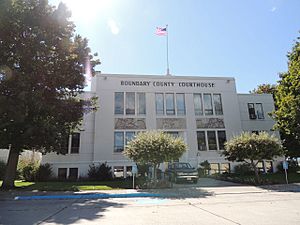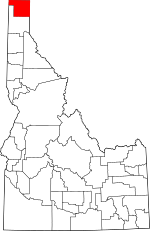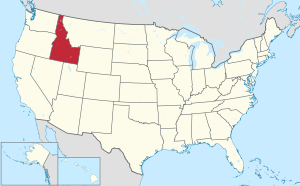Boundary County, Idaho facts for kids
Quick facts for kids
Boundary County
|
||
|---|---|---|
 |
||
|
||

Location within the U.S. state of Idaho
|
||
 Idaho's location within the U.S. |
||
| Country | ||
| State | ||
| Founded | January 23, 1915 | |
| Named for | Canada/U.S. Border | |
| Seat | Bonners Ferry | |
| Largest city | Bonners Ferry | |
| Area | ||
| • Total | 1,278 sq mi (3,310 km2) | |
| • Land | 1,269 sq mi (3,290 km2) | |
| • Water | 9.3 sq mi (24 km2) 0.7% | |
| Population
(2020)
|
||
| • Total | 12,056 | |
| • Density | 9.433/sq mi (3.6423/km2) | |
| Time zone | UTC−8 (Pacific) | |
| • Summer (DST) | UTC−7 (PDT) | |
| Congressional district | 1st | |
Boundary County is a county located in the U.S. state of Idaho. As of the 2020 census, the population was 12,056. The county seat and largest city is Bonners Ferry.
Boundary County was created by the Idaho Legislature on January 23, 1915. It is so named because it borders Canada, and is therefore the only county in Idaho with an international border. It is also only one of three counties in the United States that borders two states and a foreign country, the others being Coös County, New Hampshire and Erie County, Pennsylvania.
Contents
History
Boundary County was formed on January 23, 1915 from Bonner County. It was named Boundary County because it lies on the border of Canada, Washington and Montana.
Bonner County is presently divided into 7 election precincts: Bonners Ferry, Copeland, Kootenai, Moyie, Naples, North Bonners Ferry, and Valley View. All contain a portion of Bonners Ferry City except Copeland, Moyie, and Naples precincts. Moyie Springs was incorporated in 1947.
Settlement of the area started with the establishment of Bonners Ferry on the Kootenai River in 1864. Settlement was limited to the ferry operation until about 1890. The town of Bonners Ferry was established in 1893. At that point settlement was still sparse with small ranching and mining operations, but an expanding timber economy. By 1900, other areas started to develop with the Boulder (now Kootenai), Boundary (now Copeland), and Naples precincts first listed in the U.S. Census of that year. The Moyie precinct first appeared in the 1910 census.
In 1980, convicted spy Christopher John Boyce found refuge in Boundary County, for a few months, after his escape from the Lompoc Federal Correctional Complex. He stayed at the home of Gloria Ann White. Boyce sustained himself during his stay with a series of bank robberies in the surrounding area, allegedly with technical assistance from Ms. White.
In 1992, Boundary County was the scene of the infamous Ruby Ridge siege by 350–400 armed federal agents against Randy Weaver and his family.
| Year | Democrat | Republican |
|---|---|---|
| 2016 | 18.07% 933 | 73.39% 3,789 |
| 2012 | 29.96% 1,225 | 69.06% 3,138 |
| 2008 | 31.35% 1,484 | 65.02% 3,078 |
| 2004 | 28.96% 1,268 | 68.78% 3,012 |
| 2000 | 21.42% 832 | 72.01% 2,797 |
Geography
According to the U.S. Census Bureau, the county has a total area of 1,278 square miles (3,310 km2), of which 1,269 square miles (3,290 km2) is land and 9.3 square miles (24 km2) (0.7%) is water.
Boundary County is one of only two counties in the United States to share land borders with 2 different states and another country, along with Coös County, New Hampshire.
Adjacent counties
- Lincoln County, Montana – east
- Bonner County – south
- Pend Oreille County, Washington – west
- Regional District of Central Kootenay, British Columbia – north
National protected areas
- Pacific Northwest National Scenic Trail (part)
- Kaniksu National Forest (part)
- Kootenai National Forest (part)
- Kootenai National Wildlife Refuge
Transportation
Highways
Airports
Boundary County Airport is a county-owned, public-use airport located two nautical miles (3.7 km) northeast of the central business district of Bonners Ferry.
Demographics
| Historical population | |||
|---|---|---|---|
| Census | Pop. | %± | |
| 1920 | 4,474 | — | |
| 1930 | 4,555 | 1.8% | |
| 1940 | 5,987 | 31.4% | |
| 1950 | 5,908 | −1.3% | |
| 1960 | 5,809 | −1.7% | |
| 1970 | 6,371 | 9.7% | |
| 1980 | 7,289 | 14.4% | |
| 1990 | 8,332 | 14.3% | |
| 2000 | 9,871 | 18.5% | |
| 2010 | 10,972 | 11.2% | |
| 2020 | 12,056 | 9.9% | |
| U.S. Decennial Census 1790–1960 1900–1990 1990–2000 2010–2020 2020 |
|||
2010 census
As of the 2010 United States Census, there were 10,972 people, 4,421 households, and 2,976 families living in the county. The population density was 8.6 inhabitants per square mile (3.3/km2). There were 5,175 housing units at an average density of 4.1 per square mile (1.6/km2). The racial makeup of the county was 94.8% white, 1.7% American Indian, 0.6% Asian, 0.3% black or African American, 0.1% Pacific islander, 0.5% from other races, and 2.1% from two or more races. Those of Hispanic or Latino origin made up 3.7% of the population. In terms of ancestry, 22.5% were German, 12.8% were English, 11.2% were Irish, 7.4% were American, 5.9% were Norwegian, 5.4% were Dutch, and 5.1% were Scottish.
Of the 4,421 households, 29.7% had children under the age of 18 living with them, 55.0% were married couples living together, 7.6% had a female householder with no husband present, 32.7% were non-families, and 27.5% of all households were made up of individuals. The average household size was 2.47 and the average family size was 3.00. The median age was 42.8 years.
The median income for a household in the county was $37,712 and the median income for a family was $43,562. Males had a median income of $36,125 versus $26,076 for females. The per capita income for the county was $18,011. About 15.7% of families and 18.8% of the population were below the poverty line, including 22.0% of those under age 18 and 13.4% of those age 65 or over.
Communities
Cities
Unincorporated communities
See also
 In Spanish: Condado de Boundary para niños
In Spanish: Condado de Boundary para niños


